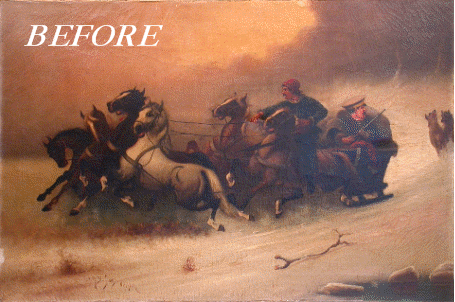
Click the down arrow at right to view answers
Can you give me a ballpark estimate for "restoring" my painting?
We are often asked for an estimate without seeing the artwork. Art conservation can be a complex endeavor..... like the field of medicine for example. Without examining the patient, a physician would not diagnose, recommend treatment, or estimate costs to cure a disease. Physicians, software engineers, automotive technicians, etc., all sell their most valuable resource: time and experience. Antique restorers, picture framers, artists, and others with less training and experience may work for much lower rates but with unexpected results ranging from satisfactory to distressing.
Please schedule an appointment to evaluate the visual and physical condition of your artworks.
During the evaluation, we will:
- carefully remove the painting from its frame
- perform solubility and other testing of surface dirt, varnish layers, pigments, binding materials, etc.
- assess physical conditions & structural problems relating to tears, paint losses, flaking, stretcher bars, etc.
- determine if it has been previously “restored”
- generate a Treatment Proposal and discuss treatment options and Estimates
- discuss the Conditions for Conservation
- plan a time table for completion of the project
- discuss your expectations and outcomes
- discuss limitations and risks
If driving to Santa Cruz is not convenient, we can bring our "mini" lab to your home for the assessment. We bill for travel time and a one hour minimum consultation. It works better for all concerned to schedule actual appointment times rather than rely on "when we are in the area."
|
Will my artwork lose value if it is conserved/restored?
Damage from an accident, mishandling, unsafe transport or storage, vandalism, alteration, previous inexpert restoration, "do-it-yourself repairs," etc. has already devalued your artwork aesthetically and monetarily. One can minimize any lasting disfigurement and resulting depreciation of the artwork by consulting a conservator and performing the necessary treatments. An artwork that is over cleaned where paint is now missing or one that is substantially over painted will be reduced in value.
|
Will conservation increase the value of my artwork?
Yes, both aesthetically and monetarily. If it is badly damaged, it has already lost value.
|
What is the difference between restoration and conservation?
Conservation encompasses actions taken toward the long-term preservation of cultural property. Conservation activities include examination, documentation, treatment, and preventative care, supported by research and education. Sometimes confusion arises about the terms "restoration" and "conservation." Restoration is actually a type of conservation treatment. It specifically refers to an attempt to bring cultural property closer to its original appearance. The other type of conservation treatment is stabilization, which refers to an attempt to maintain the integrity of cultural property and to only minimize deterioration.
|
How do I determine the value of my artwork to decide if conservation/restoration is "worth it?"
There is no way to establish monetary value on an irreplaceable heirloom with significant sentimental value. Have the conservation treatments performed because you like the artwork. If you painting has a value of under $5,000 then also have the treatments performed because you like it, not because you are going to sell it an make a fortune. If the painting has a value of over $5,000 then an strong argument can be made to have the treatments performed to increase its value.
|
My friend is an artist and says that I can fix the painting myself or she can do it. Why should I use a conservator?
Artists are wonderful people and we need them but it does not mean that they have the training or experience to implement conservation strategies and treatments. Although many of our skills overlap, artists create art whereas conservators, through specialized knowledge and training, preserve it.
|
VARA - Visual Artists Rights Act of 1990
A Congressional act that a change or conservation to a piece of fine art created specifically for exhibition whose artist is alive must be approved by the artist. A reasonable effort must be made to contact the artist, however if the artist is unreachable, then the conservator may proceed with the conservation.
|
Authorship
Artist - the work is made by the artist (usually no unqualified statement is made as to the authorship is made or intended).
Attributed to - a work in the period and in the style of the artist, may be the work of the artist, in whole or in part, but less certainty of authorship than in the preceding category.
Studio of - a work by an unknown hand in the artist's studio.
Circle of - a work of the period of the artist and closely related to the artist's style.
Style of - a work by a pupil or follower of the artist in his lifetime or shortly thereafter.
Manner of - a work in the style of the artist, possibly of a later date.
After - a copy of the known work by the artist.

The name MÖBIUS: art conservation is in memory of August Möbius, a mathematician from Leipzig, Germany, who specialized in geometry and invented the Möbius strip in 1858. The image above comes from the famous artist, M. C. Escher, who delighted in drawing visual paradoxes. It is a rectilinear interpretation of the famous curvilinear Möbius strip and is a two dimensional visual paradox that cannot exist in a three dimensional reality. When we were a fledgling business, the implication was the we could do the impossible. Now we are not quite so vainglorious, but there is a place where art, science, and magic coalesce in the realm of art conservation. Our objective is to stabilize the artwork and preserve it for posterity, which inevitably leads to pleasant visual aesthetics after the treatment.
Next
|


